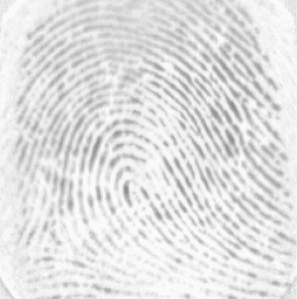
Conclusion
We have successfully implemented algorithms that perform minutiae extraction and fingerprint verification very accurately. We do need however, to perform more tests, using real images. It must be stressed that using synthesized images do not devalue our results. While the images are artificial, they are by no means excellent images without artifacts. Most of the pictures are blurred, with small holes embedded in the ridges. A typical example is Figure 1a in the pre-processing algorithm discussion page.
However, our algorithms will be sorely pressed if made to performed against really poor quality images, for example those found on the Fingerprint Verification Competition 2000 Website (FVC2000, see Figure 17). For those images, we need further preprocessing to fill the major holes and scratches found on the fingerprint. The weak point of our project is therefore image pre-processing. Given very poor images, we cannot expect the ridge tracing and therefore verification processes to work well without much more powerful pre-processing and cleaning.
Finally, we note that better and more efficient coding using C, will definitely improve the speed of our algorithms currently written in Matlab.

Figure 17.